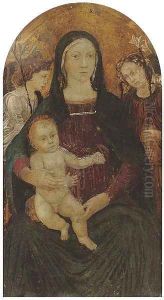The Master Of Marradi Paintings
The Master of Marradi is an anonymous Italian painter from the Renaissance period, whose works and style have been studied and admired, but whose personal details, including birth and death dates, remain largely unknown. This lack of personal detail is not uncommon among artists from this era, particularly those who did not achieve widespread fame during their lifetimes or who worked primarily in smaller communities.
The moniker 'Master of Marradi' is a notname, a term used in art history to identify an artist whose real name has been lost but whose work is distinctive enough to group under a single identifier. This name typically originates from a significant work, place of activity, or stylistic characteristic that defines the artist's oeuvre. In the case of the Master of Marradi, the name is derived from the town of Marradi, which is located in the Tuscany region of Italy. This suggests that the artist was either born in Marradi, was particularly active there, or created a significant work that is closely associated with the area.
The work of the Master of Marradi is characteristic of the Renaissance period, which spanned the 14th to the 17th century and heralded a revival of interest in the classical art and philosophy of ancient Greece and Rome. This period emphasized humanism, proportion, perspective, and a deeper, more realistic use of color and texture. While specific works attributed to the Master of Marradi can be difficult to identify with certainty due to the common practice of not signing art during this era, art historians typically attribute to him paintings that exhibit a refined use of color, detail, and religious themes characteristic of the early Renaissance.
The significance of artists like the Master of Marradi lies not only in their artistic contributions but also in the insights their works provide into the cultural, religious, and social contexts of their time. By studying the Master of Marradi's paintings, art historians can gain valuable insights into the stylistic transitions and local influences that shaped Renaissance art in Tuscany. Despite the mystery surrounding his personal life, the Master of Marradi's legacy endures through his contributions to the rich tapestry of Renaissance art.
